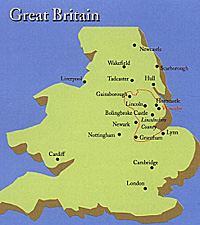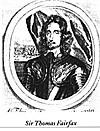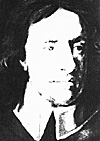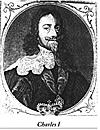
Although only a small cavalry engagement, the Battle of Winceby helped to secure the county of Lincolnshire for the Parliament. Oliver Cromwell and Thomas Fairfax, whose future participation in the English Civil War would prove so important, showed their mettle in this small but significant battle.
 The second year of the English
Civil War started with hopes of a
quick Royalist Victory. In the county
of Lincolnshire, the Royalists held the
cities of Hull and Newark. Newark,
the strategic key to the region, was
considered the gateway to northern
England. It served as a major recruiting center for the Royalists.
The second year of the English
Civil War started with hopes of a
quick Royalist Victory. In the county
of Lincolnshire, the Royalists held the
cities of Hull and Newark. Newark,
the strategic key to the region, was
considered the gateway to northern
England. It served as a major recruiting center for the Royalists.
Parliament appointed Major General Thomas Ballard to command a force of some 6,000 Roundheads to take Newark. Aware of the impending attack, the Royalist governor Sir John Henderson chose to defend the city rather than seek battle in the open.
Henderson, a Scot, had started his professional military career in the Imperial Habsburg Army during the Thirty Years War. He eventually returned to Scotand, where he received a knighthood and the Governorship of Dunbarton Castl. Just before the outbreak of the English Civil War, he accompanied his brother-in-law Lord Forth, to England, where through Forth's influence, he gained a position on the Permanent Council of War under King Charles. Henderson was sent to Denmark to raise money and mercenaries for the crown. By December he had returned to England and joined the Royahst cause.
 Upon his arrival at Newark, Ballard immediately attacked the Royalists. As a result he suffered a wound and left 200 dead Roundheads. His failure to take the city cost him his
command, and he was replaced with the able
Sir John Meldrum. Meldrum immediately
began rebuilding the Parliamentary army in
Lincolnshire, desperately trying to undo the
damage done by his predecessor.
Upon his arrival at Newark, Ballard immediately attacked the Royalists. As a result he suffered a wound and left 200 dead Roundheads. His failure to take the city cost him his
command, and he was replaced with the able
Sir John Meldrum. Meldrum immediately
began rebuilding the Parliamentary army in
Lincolnshire, desperately trying to undo the
damage done by his predecessor.
Time was not on Medrum's side, as the Royalists continued to gain in strength. In late February,Queen Henrietta Maria landed at Briddlington, located in Lincolnshire, with a large shipment of munitions from the continent.
Her valuable cargo went unmolested by Parlimamentarians as it traveled from the coast to the needy magazines of the Royalists. The arrival of Charles Cavendish's command provided the Royalists with a strike force capable of harassing the Roundheads, who had been inactive since their defeat at Newark. Henderson, with his enlarged Royalist force, now attacked, strikng first at the town of Grantham. On 23 March, Grantham fell after a brief struggle.
Upon hearing the news of the Royalist success, Sir Hugh Cholmley defected to the Royalists and ordered the port of Scarborough opened to Royalist forces. That turn of events worried the Parliamentarians who sent Thomas Fairfax to seize Tadcaster in an effort to stabilize the situation.
 Thomas Fairfax was one of the best cavalry
officers to emerge from the English Civil War.
At the time of Winceby he was just beginning
to show the talents that would later make him
such a great leader. "Black Tom," as his troops
foundly called him, compared favorably with
the Royalist's great cavalry commander Prince
Rupert. Thomas inspired his men and knew no fear in battle,
but lacked a sound gasp of the larger strategic situation. Politically, he
also lacked acumen and was eclipsed by Oliver
Cromwell, who later would become both the capable military and political leader of a united
England.
Thomas Fairfax was one of the best cavalry
officers to emerge from the English Civil War.
At the time of Winceby he was just beginning
to show the talents that would later make him
such a great leader. "Black Tom," as his troops
foundly called him, compared favorably with
the Royalist's great cavalry commander Prince
Rupert. Thomas inspired his men and knew no fear in battle,
but lacked a sound gasp of the larger strategic situation. Politically, he
also lacked acumen and was eclipsed by Oliver
Cromwell, who later would become both the capable military and political leader of a united
England.
Fairfax quickly took Tadcaster, but just as quickly lost the town to Royalists under Lord Goring. a Royalist victories followed, Goring defeating Fairfax at Seacroft Moor and Cavendish defeating the Roundheads at Ancaster Heath. Parliamentary morale in the Lincolnshire region was truly at an alltime low.
 To shore up the situation, Parliment sent Oliver Cromwell to the
area with orders to secure Lincolnshire for the Roundhead cause.
Roundhead forces in Nottingham
under John Gell were ordered to take
Newark and to link up with a small
force commanded by Lord Willoughby.
The Royalists Cavendish and Henderson replied
by joining forces and attacking the
Parliamentarians near Grantham. In a short,
intense battle, the Parliamentarians defeated the
Royalists. However, Lord Willoughby failed to
recognize the extent of his success and withdrew
his forces to Nottingham rather than pursuing his
beaten enemy. The less ambiguous success was
to come from Thomas Fairfax's daring night
attack of Wakefield. There Fairfax captured 1,500
Royalist troops and Lord Goring. Wakefield
succeeded in boosting Roundhead morale, which
increased again when Willoughby seized the town
of Gainsborough.
To shore up the situation, Parliment sent Oliver Cromwell to the
area with orders to secure Lincolnshire for the Roundhead cause.
Roundhead forces in Nottingham
under John Gell were ordered to take
Newark and to link up with a small
force commanded by Lord Willoughby.
The Royalists Cavendish and Henderson replied
by joining forces and attacking the
Parliamentarians near Grantham. In a short,
intense battle, the Parliamentarians defeated the
Royalists. However, Lord Willoughby failed to
recognize the extent of his success and withdrew
his forces to Nottingham rather than pursuing his
beaten enemy. The less ambiguous success was
to come from Thomas Fairfax's daring night
attack of Wakefield. There Fairfax captured 1,500
Royalist troops and Lord Goring. Wakefield
succeeded in boosting Roundhead morale, which
increased again when Willoughby seized the town
of Gainsborough.
Cavendish immediately surrounded Willoughby at Gainsborough and laid siege to the town. Short on supplies and lacking manpower, Willoughby could not hope to break the siege and instead awaited outside help. Relief was to come in the form of Oliver Cromwell, who had hurried from Cambridge, gathering what forces he could as he moved north. Near Scarle, Cromwell defeated Cavendish's troops, the latter dying in the battle. The siege was lifted for a few hours until yet another Royalist force, under the command of Newcastle, resumed the siege.
Cromwell was sent to Lincoln to get help and thereby narrowly avoided the fate of those left behind. In three days time, the large army of Newcastle's Royalists besieged and took the town of Gainsborough.
After his success at Gainsborough, Newcastle decided to lay siege to the city of Hull. In an attempt to break the siege, Lord Fairfax, senior, Thomas' father, ordered the dikes surrounding Hull to be broken. Newcastle's army was not dissuaded, however, but conducted a lethargic siege. It was so lacking in vigor that many Roundheads, including Cromwell, easily penetrated the siege lines and successfully entered Hull. Still, the outlook for Hull was bleak, because sooner or later even a lethargic siege would cause Hull to surrender.
On September 16, Parliamentary morale rose with the taking of the town of Lynn by the Earl of Manchester's forces. Manchester then divided his forces, sending his cavalry north under the command of Oliver Cromwell to join Willoughby and 500 infantry north to join with the forces at Hull. Meanwhile, the governor of Lincoln, Sir William Widdrington, ordered Henderson's Cavalier cavalry to Bolingbroke to defend it from an expected Roundhead attack. As Cromwell's and Henderson's forces closed, the scene was set for the battle of Winceby.
The remainder of Manchester's army proceeded to Bolingbroke, following in the wake of Cromwell's cavalry. Manchester laid siege to Bolingbroke Castle on October 9, while Henderson's Cavaliers advanced towards the castle unaware of the Roundheads' presence. Henderson's first indication of a Roundhead presence was at Horncastle, where he encountered a Parliamentarian garrison. Later in the day, when Manchester heard about the Horn- castle skirmish, he immediately dispatched Cromwell there.
On October 11 in the year of our Lord 1643, the two opposing forces of Cavaliers and Roundheads met at the town of Winceby. The Roundheads, first to spot their oppo- nents, deployed their forces south ofthe town. With the arrival of the main Parliamentarian forces, led by Thomas Fairfax, Cromwell's apprehensions about engaging the enemy due to the depletion of forces, because of his hard campaigning of the previous month, disappeared.
Now aware of the Roundheads, the Royalists began to deploy their forces along a narrow front, with Widdrington's dragoons screening the rest of the force. Henderson deployed his main force with Lord Eythin on the left and William Saville at the center and the right flank. Henderson was confident that his army, angered by Cavendish's death, would perform excellently. His intention was to strike at the Roundheads with his concen- trated forces on the left, while Saville held his right.
As both forces-approximately equal in strength-jockeyed for an advantageous position, it became clear that neither force could depend on its infantry, who were too far away, and that the ground only slightly favored the Roundheads.
The Roundheads began the battle with a charge at the Royalists' center led by Vermuyden and Cromwell. Widdrington ordered his Royalist dragoons to dismount and fire upon the roundheads. Cromwell's cavalry hit the dragoons, who had only managed one volley against their attackers, with a fury and scattered them. In the confusion of the fight, Cromwell's horse was killed, but fortunately for the Roundhead cause he survived and quickly mounted one of his trooper's horses and resumed command.
 The Royalists under William Saville
charged Cromwell's right flank in reaction to
the Roundhead assault. Saville, an ardent supporter of King Charles, thought he would
destroy Cromwell's forces with his attack but
failed to anticipate the quick response of Fairfax. William Saville so ardently supported the
King's cause against Parliament that he ordered his home of Thornhill burned to the
ground rather than have it used by the Roundheads as a base of operations. Soon it was
Saville, not Cromwell, who had his flank un-
der attack as the Roundheads closed in for the
kill. Quickly, Saville ordered his men to "face about," but alas in the confusion his men thought he had ordered a retreat. In the resulting struggle, Saville's forces disintegrated and fled from the battlefield with only the dismounted dragoons remaining.
The Royalists under William Saville
charged Cromwell's right flank in reaction to
the Roundhead assault. Saville, an ardent supporter of King Charles, thought he would
destroy Cromwell's forces with his attack but
failed to anticipate the quick response of Fairfax. William Saville so ardently supported the
King's cause against Parliament that he ordered his home of Thornhill burned to the
ground rather than have it used by the Roundheads as a base of operations. Soon it was
Saville, not Cromwell, who had his flank un-
der attack as the Roundheads closed in for the
kill. Quickly, Saville ordered his men to "face about," but alas in the confusion his men thought he had ordered a retreat. In the resulting struggle, Saville's forces disintegrated and fled from the battlefield with only the dismounted dragoons remaining.
On the Royalist left, Henderson and Eythin enjoyed an initial success against the Roundheads that lessened considerably as their center and right flank crumbled under Cromwell's onslaught. As Henderson attempted to extricate his army from a potential envelopment,the morale of his toops began to weaken. Crommwell, with his cavalry now reformed after their devastating blow on the Royalist right and center, struck at the remaining Royalist force. Henderson's troops' will to fight deserted them,and they fled for their lives with the Roundheads in pursuit.
For the remainder of the day, Roundhead cavalry sought out and killed the fleeing Royalist troops. Later, names like Slash Hollow and Slash Lane would be given to places where Rogalists met their end by a Roundhead sword. By dusk there was little left ofthe Royalists, and the Roundhead cavalry was recalled by the Earl of Manchester.
Although Winceby was a small battle in the English Civil War, its ramifications were great. The Roundhead victory ensured the fall of Bolingbroke Castle and ended the Royalist siege of Hull. Finally, it ensured that Lincolnshire would remain Parlamentarian. The early gloom in which 1643 had begun was replaced with new hope for the cause of Parliament against the King.
Note on Sources
Winceby is unfortunately not covered in some detail in most sources. By and far the best source of information on the battle and the basis for both the article and game is The Battle of Winceby 1643 by David Frampton and Peter Garnham, published by Partizan Press.
Chronology of the English Civil Wars
Back to Table of Contents #5
© Copyright 1995 by One Small Step, Inc.